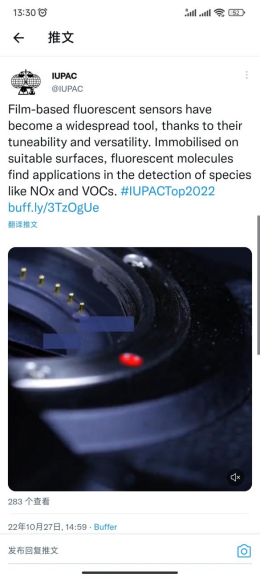On October 17, the International Union of Pure and Applied Chemistry (IUPAC) released the 2022 Top Ten Emerging Technologies in Chemistry, and the film-based fluorescence sensors based on the research of Prof. Fang Yu’s group was selected among the top ten emerging technologies.
Film-based fluorescence sensing is considered to be the most promising microtrace material detection technology after ion mobility spectroscopy due to its excellent sensitivity, selectivity, tunability and universality. In the corresponding devices, fluorescently active molecules are usually immobilised on a suitable surfaces that can be as small as under one centimetre in size to form 2D or 3D films with a rapid reversible response to external stimuli, which plays an efficient detection function for microtrace substances. This type of fluorescent sensors have the advantages of small size, low power consumption and simple operation, and has an outstanding advantage in the miniaturization of portable sensors.
Since 1998, based on the major needs of national security, Prof. Fang Yu’s group has carried out a series of in-depth and comprehensive research work on the difficulties of film-based fluorescence sensing technology, such as being easily disturbed by environmental factors, unsatisfactory selectivity and sensitivity in meeting special detection needs. They proposed the concepts of excited state micro-environmental effect, shielding/enrichment effect of connecting arm layer, and sidechain conformation effect, and developed film preparation strategies such as chemical assembly, gel-mediated, combinational design and dynamic polymerization of interface confinement, and obtained time-containing sensing information through independent construction of the system, and used it for the discrimination and detection of complex samples, realizing a new leap in sensing performance, sensing mechanism and film preparation.
So far, they have developed a series of film-based fluorescence sensors that can efficiently detect TNT, ammonia compounds, nitrogen oxides, organic volatiles, pesticides, nerve agents, nicotine, pathogens, etc., creating the fastest response and the most sensitive film fluorescence detection record of explosives and drugs. They developed the SRED series hidden explosives and narcotics fluorescent sensors and detection equipment with completely independent intellectual property rights, and incubated Shenzhen SRED Security and Surveillance Technology Co., Ltd., specializing in the industrial research, and development, production and sale of film-based fluorescent sensors. The related products have been used in the security of major events and important venues such as the CPC 19th National Congress, G20 Summit, Boao Forum, top official’s train, Central Military Commission, Uganda Presidential Office, Daxing Airport, Shenzhen Metro, etc., and began to be deployed by the military in 2019. The film-based fluorescent sensor and detection equipment for narcotics pioneered by them have also begun to be applied. The development of film-based fluorescent sensors and equipment involving ultra-sensitive detection of high-risk substances such as chemical warfare agents, nerve agents and pathogens is also in progress.
The top ten emerging technologies announced are sodium-ion batteries, nanozymes, aerogels, film-based fluorescence sensors, nanoparticle mega libraries, fiber-based batteries, liquid solar fuel synthesis, textile displays, rational vaccines with SNA and VR-enabled interactive modeling. These technologies are defined as transformative innovations in between a discovery and a fully-commercialized technology, having outstanding potential to open new opportunities in chemistry, sustainability, and beyond.
The International Union of Pure and Applied Chemistry (IUPAC) was founded in 1918 as the International Congress of Applied Chemistry, whose mission is to address issues related to the discipline of chemistry of global concern. Its widely recognized representative work is to unify the naming standards for chemical elements and their compounds, and has the final decision onelement naming and symbolization.

IUPAC发布网址:https://iupac.org/iupac-2022-top-ten/
Link ofIUPAC release:https://iupac.org/iupac-2022-top-ten/
Chemistry International文章链接:https://doi.org/10.1515/ci-2022-0402
Link ofChemistry International article:https://doi.org/10.1515/ci-2022-0402


 Latest Updates
Latest Updates






